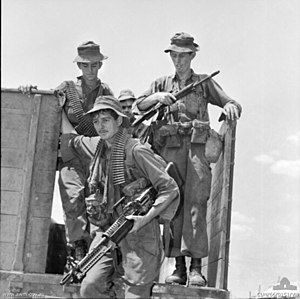| Battle of Suoi Bong Trang | |||||||
|---|---|---|---|---|---|---|---|
| Part of the Vietnam War | |||||||
 Australian soldiers returning to Bien Hoa airbase following Operation Rolling Stone, late February 1966. | |||||||
| |||||||
| Belligerents | |||||||
|
|
| ||||||
| Commanders and leaders | |||||||
|
| |||||||
| Units involved | |||||||
|
2 platoons of M48 Patton tanks |
| ||||||
| Strength | |||||||
| ~2,000 | |||||||
| Casualties and losses | |||||||
|
About 200 killed (Vietnamese claim) 72 wounded 1 tank destroyed 2 tanks and four APCs damaged |
US body count: 154 killed 200 wounded 15 captured | ||||||
The Battle of Suoi Bong Trang (23–24 February 1966) was an engagement fought between US, Australian and New Zealand forces, and the Viet Cong and North Vietnamese Army during the Vietnam War. The battle occurred during Operation Rolling Stone, an American security operation to protect engineers building a tactically important road in the vicinity of Tan Binh, in central Binh Duong Province, 30 kilometres (19 mi) north-west of Bien Hoa airbase. During the fighting, soldiers from the US 1st Brigade, 1st Infantry Division and the 1st Battalion, Royal Australian Regiment (1 RAR), which had been attached for the operation, fought off a regimental-sized Viet Cong night assault. Repulsed by massed firepower from artillery and tanks, the Viet Cong suffered heavy casualties and were forced to withdraw by morning. After the attack, the Americans and Australians made no attempt to pursue the Viet Cong, focusing on securing the battlefield and evacuating their own casualties. The Viet Cong continued to harass the American sappers with occasional sniper and mortar fire, but these tactics proved ineffective, and the road was completed by 2 March.
